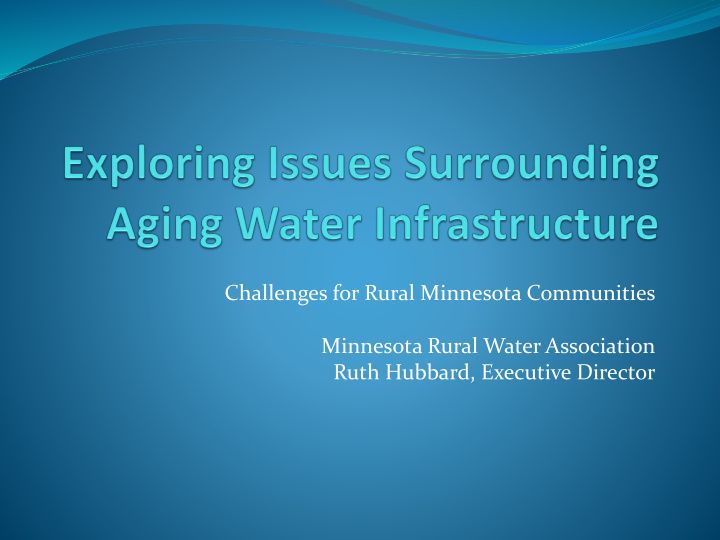



Challenges for Rural Minnesota Communities Minnesota Rural Water Association Ruth Hubbard, Executive Director
Challenges for Rural Minnesota Communities Minnesota Rural Water Association Established in 1978 Training, source water protection and on-site technical assistance Operation Specialists, Administrators, Governing Officials Operation, maintenance, protection and financial aspects of sustaining systems
Challenges for Rural Minnesota Communities Minnesota Rural Water Association Staff of 17 statewide (Bemidji to Faribault) 24,000 training hours 3,200 system personnel trained 4,000 on-site hours at systems 322,oo0 miles driven in performance of services 140 contacts with systems each month National Rural Water Association Largest utility organization with 32,000 members
Challenges for Rural Minnesota Communities Two goals in mind… Protection of Public Health Compliance with all current regulations Act as liaison between primacies and systems Source Water Protection Plans Protection of investment of infrastructure Proper operation and maintenance Proper state reporting Proper planning
Challenges for Rural Minnesota Communities Cost of system improvements City of Morgan Pop.885, MHI-$41,420, $23,739,000 total project costs $12,432,000 loan, $11,307,000 grant City of Sacred Heart Pop. 524, MHI - $32,778, $9,677,000 total project costs $3,242,000 loan, $6,435,000 grant City of Maynard Pop. 358, MHI-$40,625, $4,993,000 total project costs $1,664,000 loan, $3,329,000 grant
Challenges for Rural Minnesota Communities That scenario can be repeated all across Minnesota State funding agencies use 1.4% of median household income as “affordability” Cost per household, per month, per utility equals $35.00 to $100.00 plus Using MHI as a determining unit already means that ½ of the households fall below that affordability Rural Water Systems are likely to pay an additional $18,000 plus as an assessment
Challenges for Rural Minnesota Communities Need for system improvements vary Failing infrastructure (old age) Change in regulations (i.e. arsenic, radium, phosphorus removal, chlorides Contamination (i.e. nitrates caused by land uses usually at no fault of the system owner
Challenges for Rural Minnesota Communities Financial Partners Minnesota Department of Health Minnesota Pollution Control Agency Public Facilities Authority Rural Development State of Minnesota WIF Small Cities Grant Local tax dollar Customers
Challenges for Rural Minnesota Communities NEEDS… Repair and replace failing infrastructure Protect and Preserve their investment Management, Technical & Finance (M-T-F) Capacity Development Sustainability Asset Management ALL ARE SIMILAR…………………
Challenges for Rural Minnesota Communities Asset Management that works for small and very small water and wastewater systems Available software was too comprehensive (scary!) Conversations with MDH, MPCA, PFA, RD on designing our own template Selection of willing participants Development (and redevelopment) of template Digging through old system records
Challenges for Rural Minnesota Communities Asset Management Tool Tracks condition, original and depreciated value, maintenance, replacement date and criticality of assets Needed to determine available information from pilot cities; maps, maintenance records, costs Pilot systems included St. Martin, Clear Lake and Cyrus WHY???
Challenges for Rural Minnesota Communities Template includes… Asset, condition, original and depreciated value, maintenance , replacement date and criticality of component Taking the guess work out of evaluating system components Collection or distribution system installation date is 1934 – condition is “poor” (system might argue otherwise) Needs to be part of Capital Improvement Plan for future projects even though the pipe are still working
Challenges for Rural Minnesota Communities Criticality – what’s that?? What is the probability of failure What is the consequence (cost) of failure Can an asset be repaired or replaced with minimal impact to your operation or does the failure put your customers in danger of public health issues Worked with these 6 systems over a 9 month period of time
Challenges for Rural Minnesota Communities Pilot Program comments: “It is a lot of work!” “It is a good tool!” “Not sure upkeep of the template will be a priority!!” “You will need to come back annually to update the template for me!” Currently working on an additional 10 plans; Holdingford, Gary, Lowry, Clarissa and Evansville.
Challenges for Rural Minnesota Communities AND…systems will soon be forced to replace many of their most experienced employees. Between 2010 and 2020, the water sector alone is expected to lose between 30 and 50 percent of the workforce to retirement. Many of these employees have worked at the same utility for the majority of their careers, and they will depart with decades of valuable institutional knowledge. Now is the time that these assets need to be located, recorded and valued to make this information available to the new generation of personnel who will ultimately take responsibility of these systems.
Challenges for Rural Minnesota Communities THANK YOU For your support of water and wastewater infrastructure in Minnesota. For your support of grants and principal forgiveness to make these improvements more affordable For recognizing that the safety of affordable drinking water and disposal of wastewater in an environmentally protective manner is both a rural and urban issue For your support of the Lewis & Clark Rural Water System in southwest Minnesota
Recommend
More recommend